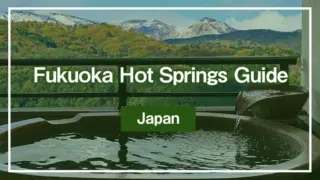Many tourists who visit Japan tend to tour Tokyo first. However, each region of Japan has its own history, tourist attractions, and historical sites, so it would be a shame to only visit Tokyo. Japan is broadly divided into Eastern and Western Japan, and Western Japan has many attractions of its own.
This article explains the characteristics and representative tourist spots of each area in Western Japan, including Osaka and Fukuoka. If you’re considering visiting places other than Tokyo during your trip to Japan, please read on.
1. Southern Japan Travel Spots: Kinki Region
The Kinki region, with its deeply rooted culture and history in Western Japan, is an area rich in tourism resources centered around Kyoto, Osaka, and Nara. Its charm lies in the atmosphere of ancient capitals, traditional architecture, and harmony with nature, with scenery that can be considered quintessentially Japanese spread throughout the area. Here, we introduce Himeji Castle and Koyasan, which are particularly popular historical spots in the Kinki region.
1-1. Himeji Castle (Hyogo Prefecture)
Himeji Castle, characterized by its elegant white appearance, is a historic castle that was the first in Japan to be registered as a World Cultural Heritage site.
Affectionately known as the “White Heron Castle,” Himeji Castle is also designated as a National Treasure, and its beautiful appearance created by white plastered walls and a five-story, six-level keep is considered the epitome of Japanese architecture. It was built at the end of the 14th century and expanded to its current scale in the early Edo period. Having escaped war and earthquakes, it is known as a precious surviving wooden keep.
The grounds feature defensive innovations throughout, and its structure combining elegance and robustness is one of the highlights. With its beauty harmonizing with the scenery of the four seasons, it boasts high popularity among domestic and international tourists.
1-2. Koyasan (Wakayama Prefecture)
Koyasan is a sacred site of Shingon Esoteric Buddhism with over 1,200 years of history and is the perfect place for those seeking peace of mind. Located in northern Wakayama Prefecture, Koyasan is known as an important place of Buddhist practice in Japan, established by Kobo Daishi (Kukai). The entire mountain is structured like one temple, with Okunoin and Kongobuji Temple being popular destinations visited by many worshippers.
Surrounded by rich nature, at Koyasan you can tour historic buildings in a quiet atmosphere, experience shojin ryori (Buddhist vegetarian cuisine) and morning services at temple lodgings, allowing you to clear your mind away from daily life. It’s a destination filled with healing and discovery that even those unfamiliar with religion can enjoy.
2. Southern Japan Travel Spots: Chugoku Region
The Chugoku region has spots that leave an impression on visitors’ hearts, such as Hiroshima, which conveys the memory of the atomic bomb, and Tottori, where Japan’s largest sand dunes spread out. Among trips around Western Japan, the Chugoku region has many places of interest and is an area where you can experience learning and emotion. Here, we introduce the “Hiroshima Peace Memorial Park” and “Tottori Sand Dunes” as particularly recommended tourist spots.
2-1. Hiroshima Peace Memorial Park (Hiroshima Prefecture)
Hiroshima Peace Memorial Park is a place that conveys the devastation of the atomic bomb and transmits the importance of peace to the world. Located in the center of Hiroshima, where an atomic bomb was dropped in 1945, this park was developed to convey the horrors of war and the preciousness of life to the present day. Within the park are the Atomic Bomb Dome, registered as a World Heritage site, a cenotaph for atomic bomb victims, the Peace Memorial Museum, and other sites visited by many people who wish for peace.
The lush green park is also suitable for strolling, allowing visitors to face history while offering quiet prayers. It is one of Western Japan’s representative meaningful tourist destinations where visitors can once again feel the importance of peace.
2-2. Tottori Sand Dunes (Tottori Prefecture)
The Tottori Sand Dunes are Tottori Prefecture’s representative tourist spot where you can enjoy Japan’s largest sand landscape. Facing the Sea of Japan, the Tottori Sand Dunes extend 2.4 km north-south and 16 km east-west, with a dynamic natural topography whose charm lies in the unique landscape created by wind and sand over tens of thousands of years. The vast sand hills that can be viewed from the water’s edge give you the feeling of being in a foreign desert.
Tourists can walk up the dunes, ride camels, and enjoy activities such as paragliding and sandboarding. One of its attractions is that the expression of the wind patterns changes with the seasons and weather, offering new discoveries with each visit.
3. Southern Japan Travel Spots: Shikoku Region
The Shikoku region, consisting of four prefectures, is an area rich in nature and culture that exudes unique charm within Western Japan. Surrounded by mountains and sea in a quiet environment, you can enjoy a journey that heals your mind and body with historic temples and hot spring areas. Here, we introduce the 88 Sacred Temples of Shikoku, famous as a pilgrimage site, and Dogo Onsen, considered one of Japan’s oldest hot springs.
3-1. 88 Sacred Temples of Shikoku (Kagawa, Tokushima, Kochi, and Ehime Prefectures)
The 88 Sacred Temples of Shikoku is a special travel route where you can experience Japan’s traditional pilgrimage culture. This pilgrimage involves visiting 88 temples associated with Kukai (Kobo Daishi), who spread Buddhism in Japan, making a complete circuit of Shikoku’s four prefectures (Tokushima, Kochi, Ehime, and Kagawa), covering a total distance of about 1,400 km. While it was once a path for ascetic practice, it is now popular among those who want to calm their minds and travelers who want to enjoy nature.
You can go around by foot, bus, rental car, and various other methods, enjoying a unique travel style that includes traditional culture, interaction with local people, and beautiful scenery unique to Japan.
3-2. Dogo Onsen (Ehime Prefecture)
Dogo Onsen in Matsuyama City, Ehime Prefecture, is known as one of Japan’s oldest hot springs, a hot spring area where you can feel tradition and elegance.
Said to have a history of 3,000 years, it is a famous spring that has long been favored by emperors and literary figures. Particularly famous is the “Dogo Onsen Honkan,” a Meiji-era wooden building with a retro and elegant atmosphere, said to be one of the models for the bathhouse in Studio Ghibli’s film “Spirited Away.”
The water is colorless and transparent, soft, and gentle on the skin. In addition to bathing in the hot spring, you can also enjoy the surrounding shopping streets, foot baths, and tourist trains, making it recommended for those who want to spend relaxing, quintessentially Japanese healing time.
4. Southern Japan Travel Spots: Kyushu & Okinawa Region
The Kyushu and Okinawa region stands out for its diversity of nature and culture within Western Japan. Both Kyushu, with its volcanoes and hot springs, and Okinawa, with its blue seas and unique traditions, offer extraordinary experiences to visitors. Here, we introduce Aso-Kuju National Park, where you can fully enjoy nature, and Shuri Castle, which conveys the history of the Ryukyu Kingdom to the present day.
4-1. Aso-Kuju National Park (Kumamoto Prefecture)
Aso-Kuju National Park is a natural tourist destination representative of Kyushu where you can enjoy magnificent volcanic topography and nature throughout the four seasons. The park extends from Kumamoto Prefecture to Oita Prefecture, with attractions including the world’s largest caldera at Mount Aso and the gentle mountain range of the Kuju Mountains, creating a dynamic landscape. Smoke still rises from the active volcano Mount Nakadake, allowing you to feel the power of nature up close.
The scenery of cattle and horses grazing freely in the grasslands gives you a sense of the distinctive tranquility of Japan. With various activities including hiking, hot springs, and stargazing, it’s the perfect spot for travelers who want to fully enjoy nature.
4-2. Shuri Castle (Okinawa Prefecture)
Shuri Castle is a castle that symbolizes Okinawa’s history and culture, having flourished as the center of the former Ryukyu Kingdom. Located in Naha City on Okinawa’s main island, Shuri Castle was the political, diplomatic, and cultural center of the Ryukyu Kingdom, which existed from the 15th to the 19th century. It is characterized by its unique architectural style influenced by exchanges with China and Japan, and its vibrant vermilion exterior, and was registered as a World Heritage site.
Although the main hall was lost in a fire in 2019, restoration work is currently underway and the process can be visited. The grounds also include exhibitions and gardens where you can feel the former royal culture, making it a valuable spot to experience Okinawa’s unique history firsthand.
Conclusion
Western Japan is a place where numerous tourist spots are scattered, allowing you to deeply experience Japan’s history, culture, and natural attractions. Himeji Castle and Koyasan in the Kinki region, Hiroshima Peace Memorial Park and Tottori Sand Dunes in the Chugoku region, the 88 Sacred Temples of Shikoku and Dogo Onsen in the Shikoku region, and Aso-Kuju National Park and Shuri Castle in the Kyushu and Okinawa region—each region’s distinctive characteristics stand out. Western Japan, packed with different charms in each area, is a travel destination that brings new discoveries to both first-time travelers and repeat visitors.
*This article is based on information available as of April 2025.


























